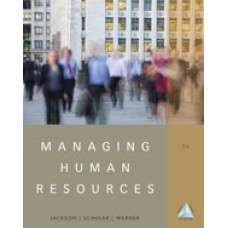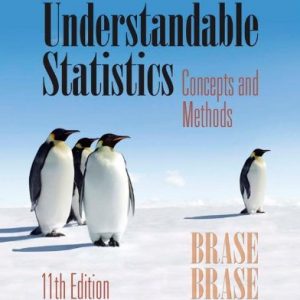This is completed downloadable of Solution Manual for Managing Human Resources, 11th Edition

Product Details:
- ISBN-10 : 1259911926
- ISBN-13 : 978-1259911927
- Author: Wayne Cascio
Managing Human Resources 11e is for the general management student whose job inevitably will involve responsibility for managing people. It explicitly links the relationship between productivity, quality of work life, and profits to various human resource management activities and as such, strengthens the students’ perception of human resource management as an important function, which affects individuals, organizations, and society. It is research-based and contains strong links to the applicability of this research to real business situations.
Table of Content:
- Part One Environment
- Chapter 1 Human Resources in a Globally Competitive Business Environment
- Questions This Chapter Will Help Managers Answer
- Human Resource Management in Action
- The Enterprise Is the People
- Managing People: A Critical Role for Every Manager
- Why Does Effective HRM Matter?
- Features of the Competitive Business Environment
- Responses of Firms to the New Competitive Realities
- Productivity: What Is It, and Why Is It Important?
- Quality of Work Life: What Is It?
- Business Trends and HR Competencies
- Human Resource Management in Action: Conclusion
- Summary
- Key Terms
- Discussion Questions
- Applying Your Knowledge
- References
- Chapter 2 HR Technology
- Questions This Chapter Will Help Managers Answer
- Human Resource Management in Action
- Technology and Its Impact on HR Management
- Leveraging HR Technology—Human Resource Information Systems (HRIS)
- Challenges Facing HR Technology
- HR Technology Trends
- Human Resource Management in Action: Conclusion
- Summary
- Key Terms
- Discussion Questions
- Applying Your Knowledge
- References
- Chapter 3 Talent Analytics: The Financial Impact of HRM Activities
- Questions This Chapter Will Help Managers Answer
- Human Resource Management in Action
- Big Data: Promise and Perils
- The LAMP Model: Foundation for Workforce Measurement
- Financial Effects of Employee Attitudes
- Costing Employee Absenteeism
- Costing Employee Turnover
- Financial Effects of Work–Life Programs
- Financial Effects of Collaboration and Sharing Knowledge
- Human Resource Management in Action: Conclusion
- Summary
- Key Terms
- Discussion Questions
- Applying Your Knowledge
- References
- Chapter 4 The Legal Context of Employment Decisions
- Questions This Chapter Will Help Managers Answer
- Human Resource Management in Action
- Societal Objectives
- EEO and Unfair Discrimination: What Are They?
- The Legal Context of Human Resource Decisions
- Federal Enforcement Agencies: EEOC and OFCCP
- Employment Case Law: Some General Principles
- Human Resource Management in Action: Conclusion
- Summary
- Key Terms
- Discussion Questions
- Applying Your Knowledge
- References
- Part Two EMPLOYMENT
- Chapter 5 Diversity at Work
- Questions This Chapter Will Help Managers Answer
- Human Resource Management in Action
- The Many Dimensions of Workforce Diversity
- Diversity at Work
- Managing Diversity
- Human Resource Management in Action: Conclusion
- Summary
- Key Terms
- Discussion Questions
- Applying Your Knowledge
- References
- Chapter 6 Planning for People
- Questions This Chapter Will Help Managers Answer
- Human Resource Management in Action
- Business Strategy—Foundation for All Organizational Decisions
- Relationship of HR Strategy to Business Strategy
- Jobs and Work: Constant Change
- Alternative Perspectives on Jobs
- From Job Analysis to Strategic Workforce Planning
- Talent Inventory
- Workforce Forecasts
- Control and Evaluation of SWP Systems
- Human Resource Management in Action: Conclusion
- Summary
- Key Terms
- Discussion Questions
- Applying Your Knowledge
- References
- Chapter 7 Recruiting
- Questions This Chapter Will Help Managers Answer
- Human Resource Management in Action
- Recruitment as a Strategic Imperative
- A Supply-Chain Approach to the Recruitment–Staffing Process
- Recruitment Planning
- Internal Recruitment
- External Recruitment
- Diversity-Oriented Recruiting
- Managing Recruitment Operations
- The Other Side of Recruitment—Job Search
- Human Resource Management in Action: Conclusion
- Summary
- Key Terms
- Discussion Questions
- Applying Your Knowledge
- References
- Chapter 8 Staffing
- Questions This Chapter Will Help Managers Answer
- Human Resource Management in Action
- Organizational Considerations in Staffing Decisions
- Screening and Selection Methods
- Assessment Methods in Selection
- Choosing the Right Predictor
- Human Resource Management in Action: Conclusion
- Summary
- Key Terms
- Discussion Questions
- Applying Your Knowledge
- Technical Appendix
- References
- Part Three DEVELOPMENT
- Chapter 9 Training and on-Boarding
- Questions This Chapter Will Help Managers Answer
- Human Resource Management in Action
- Employee Training
- Characteristics of Effective Training Practice
- What Determines Effective Training?
- Assessing Training Needs and Designing Training Programs
- Principles That Enhance Learning
- Evaluating Training Programs
- Additional Considerations in Measuring the Outcomes of Training
- New-Employee Orientation: The On-Boarding Process
- Planning, Packaging, and Evaluating an On-Boarding Program
- Lessons Learned
- Human Resource Management in Action: Conclusion
- Summary
- Key Terms
- Discussion Questions
- Applying Your Knowledge
- References
- Chapter 10 Performance Management
- Questions This Chapter Will Help Managers Answer
- Human Resource Management in Action
- Managing for Maximum Performance
- Purposes of Performance-Appraisal Systems
- Alternative Methods of Appraising Employee Performance
- Who Should Evaluate Performance?
- When and How Often Should Appraisal Be Done?
- Evaluating the Performance of Teams
- Appraisal Errors and Rater-Training Strategies
- Secrets of Effective Performance-Feedback Interviews
- Human Resource Management in Action: Conclusion
- Summary
- Key Terms
- Discussion Questions
- Applying Your Knowledge
- References
- Part Four COMPENSATION
- Chapter 11 Pay and Incentive Systems
- Questions This Chapter Will Help Managers Answer
- Human Resource Management in Action
- Changing Philosophies Regarding Pay Systems
- Components and Objectives of Organizational Reward Systems
- Strategic Integration of Compensation Plans and Business Plans
- Determinants of Pay Structure and Level
- An Overview of Pay-System Mechanics
- Policy Issues in Pay Planning and Administration
- Performance Incentives
- Requirements of Effective Incentive Systems
- Merit-Pay Systems
- Guidelines for Effective Merit-Pay Systems
- Incentives for Executives
- Incentives for Lower-Level Employees
- Team Incentives
- Organizationwide Incentives
- Human Resource Management in Action: Conclusion
- Summary
- Key Terms
- Discussion Questions
- Applying Your Knowledge
- References
- Chapter 12 Indirect Compensation: Employee Benefit Plans
- Questions This Chapter Will Help Managers Answer
- Human Resource Management in Action
- Strategic Considerations in the Design of Benefits Programs
- Components of the Benefits Package
- Benefits Administration
- Human Resource Management in Action: Conclusion
- Summary
- Key Terms
- Discussion Questions
- Applying Your Knowledge
- References
- Part Five LABOR–MANAGEMENT ACCOMMODATION
- Chapter 13 Union Representation and Collective Bargaining
- Questions This Chapter Will Help Managers Answer
- Human Resource Management in Action
- Why Do Employees Join Unions?
- Union Membership in the United States
- The Changing Nature of Industrial Relations in the United States
- Fundamental Features of the U.S. Industrial Relations System
- The Unionization Process
- Collective Bargaining: Cornerstone of American Labor Relations
- Bargaining Impasses: Strikes, Lockouts, and Third-Party Involvement
- Administration of the Collective-Bargaining Agreement
- Union Membership in Countries Other Than the United States
- Union Wage Premiums and the Spillover Effect
- Human Resource Management in Action: Conclusion
- Summary
- Key Terms
- Discussion Questions
- Applying Your Knowledge
- References
- Chapter 14 Procedural Justice and Ethics in Employee Relations
- Questions This Chapter Will Help Managers Answer
- Human Resource Management in Action
- Some Definitions
- Why Address Procedural Justice?
- Components of Procedural Justice
- Procedural Justice in Action: Employee-Voice Systems
- Grievance Procedures in Nonunion Companies: Workplace Due Process
- Employee Privacy and Ethical Issues
- Human Resource Management in Action: Conclusion
- Summary
- Key Terms
- Discussion Questions
- Applying Your Knowledge
- References
- Part Six SUPPORT AND INTERNATIONAL IMPLICATIONS
- Chapter 15 Safety, Health, and Employee Assistance Programs
- Questions This Chapter Will Help Managers Answer
- Human Resource Management in Action
- The Extent and Cost of Safety and Health Problems
- The Occupational Safety and Health Act
- Assessing the Costs and Benefits of Occupational Safety and Health Programs
- Organizational Safety and Health Programs
- Health Hazards at Work
- Employee Assistance Programs
- Corporate Health Promotion: The Concept of “Wellness”
- Human Resource Management in Action: Conclusion
- Summary
- Key Terms
- Discussion Questions
- Applying Your Knowledge
- References
- Chapter 16 International Dimensions of Human Resource Management
- Questions This Chapter Will Help Managers Answer
- Human Resource Management in Action
- The Global Corporation: A Fact of Modern Organizational Life
- The Role of Cultural Understanding in International Management Practice
- Human Resource Management Practices as a Cultural Variable
- Human Resource Management Activities of Global Corporations
- Repatriation
- Human Resource Management in Action: Conclusion
- Summary
- Key Terms
- Discussion Questions
- Applying Your Knowledge
- References
- Glossary
- Name Index
- Subject Index





